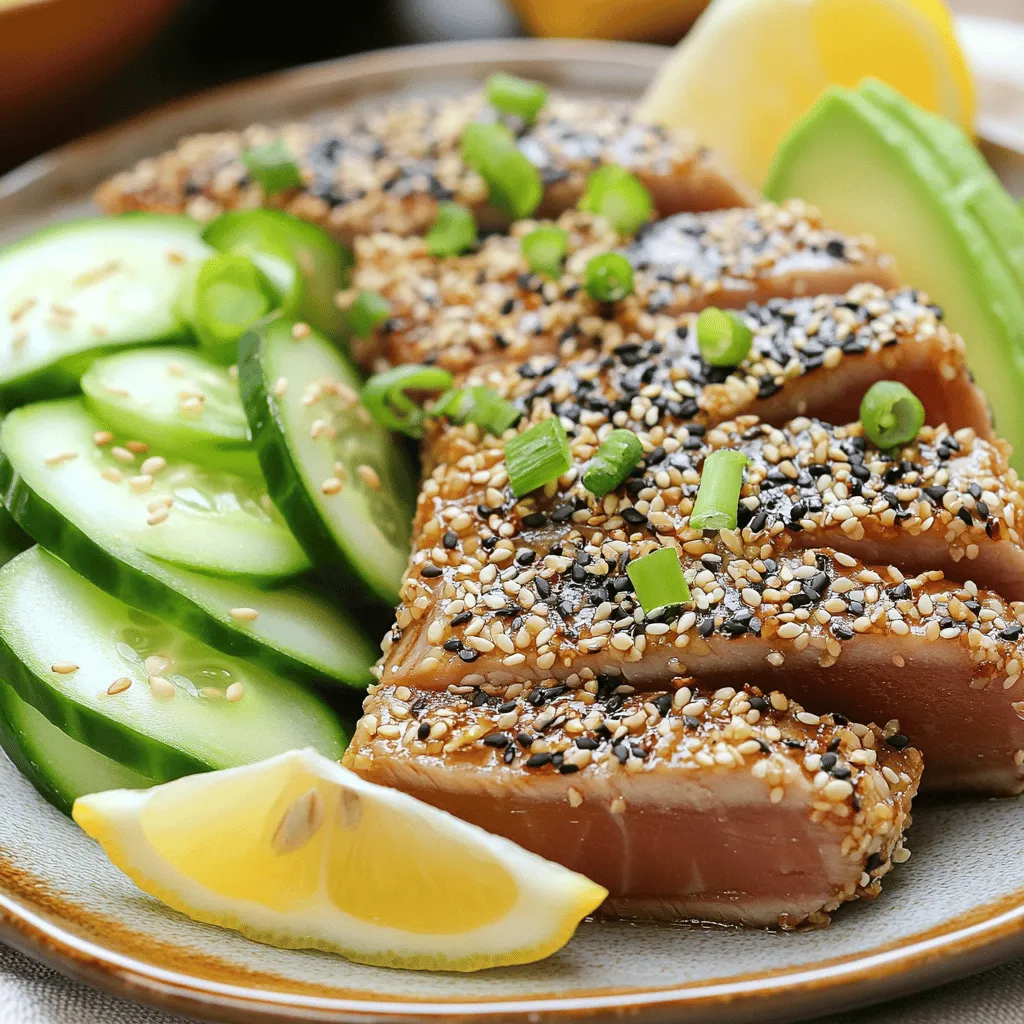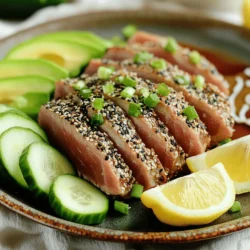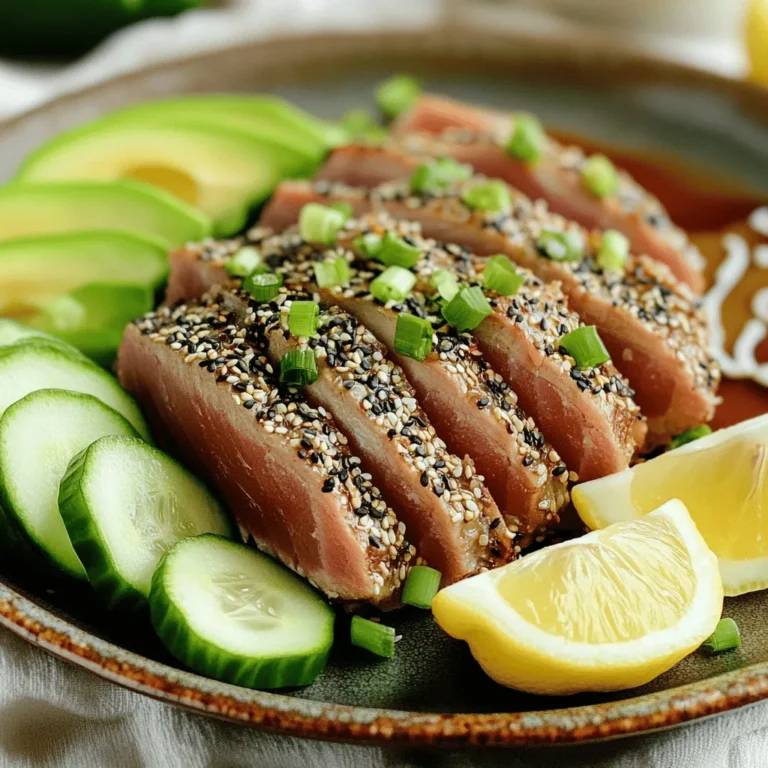If you crave a dish that’s both tasty and healthy, you’re in for a treat! My sesame crusted ahi tuna is a showstopper. With its crunchy exterior and tender inside, this dish is simple to make but impressive to serve. Packed with flavor and nutrients, it uses fresh ingredients like avocado and ginger. Plus, I’ll share tips and tricks to help you nail the perfect crust. Let’s dive into this delicious recipe!
Ingredients
Main Ingredients
– 2 ahi tuna steaks (approximately 6 oz each)
– 1/4 cup black sesame seeds
– 1/4 cup white sesame seeds
– 2 tablespoons olive oil, plus more for cooking
Flavor Enhancers
– 1 tablespoon soy sauce
– 1 teaspoon freshly grated ginger
– 1 teaspoon wasabi paste (optional for an extra kick)
Accompaniments
– 1 ripe avocado, sliced
– 1 small cucumber, thinly sliced
– 2 green onions, chopped
The main ingredients for this dish are fresh ahi tuna steaks, sesame seeds, and olive oil. Ahi tuna is tasty and packed with protein. The sesame seeds give a crunchy crust that adds flavor and texture. Olive oil helps to cook the tuna and adds a smooth taste.
For flavor, I use soy sauce, ginger, and optional wasabi paste. Soy sauce brings a savory depth. Ginger adds warmth, while wasabi gives a spicy kick. You can skip the wasabi if you prefer a milder taste.
Finally, I serve the tuna with fresh avocado, cucumber, and green onions. The creamy avocado balances the fish’s richness. Cucumber adds a crisp texture, and green onions offer a fresh pop. Together, these ingredients create a colorful and healthy meal.
Step-by-Step Instructions
Preparing the Sesame Seed Coating
First, mix the black and white sesame seeds in a shallow dish. This blend gives the tuna a beautiful look and crunch. Next, pat the ahi tuna steaks dry with paper towels. This step helps the seasoning stick. Season both sides with salt and pepper. Make sure to use enough to enhance the flavor.
Flavoring the Tuna
Now, whisk together the olive oil, soy sauce, and freshly grated ginger in a small bowl. If you want some heat, add wasabi paste. This mixture will add great flavor to the tuna. Use a pastry brush to coat each tuna steak evenly. This adds moisture and helps the sesame seeds stick.
Cooking the Tuna
Heat a non-stick skillet over medium-high heat and add olive oil. Wait until the oil shimmers and is hot. Carefully place the sesame-crusted tuna steaks in the skillet. Sear each side for 1-2 minutes for medium-rare. If you prefer your tuna more cooked, add another minute or two per side.
Once cooked, transfer the tuna to a cutting board. Let it rest for about a minute. This resting time keeps the juices inside the fish. After resting, slice the tuna into thin strips, at a slight angle. This creates a nice presentation for your dish.
Serve the sliced tuna on a plate with avocado and cucumber slices. Sprinkle with chopped green onions for a fresh touch. Drizzle any remaining soy-ginger mixture over the top. Add lemon wedges on the side for a zesty finish. Enjoy this tasty and healthy delight!
Tips & Tricks
Achieving the Perfect Crust
To get a great crust on your sesame-crusted ahi tuna, follow these simple tips:
– Ensuring seeds adhere well: Press the tuna firmly into the sesame seeds. This helps them stick. Make sure the tuna is dry before you season it. A dry surface grabs the seeds better.
– Cooking time for desired doneness: Sear the tuna for 1-2 minutes on each side for medium-rare. If you want it more cooked, add another minute per side.
Serving Suggestions
When it comes to serving, presentation matters:
– Plate presentation tips: Arrange the sliced tuna neatly on the plate. Place the avocado and cucumber around it for color and texture.
– Garnishing ideas: Top the tuna with chopped green onions. A drizzle of the soy-ginger mix adds a tasty touch.
Pairing Recommendations
Pair your dish for a full dining experience:
– Best sides to serve: Steamed rice or a fresh salad works well. You could also try a light seaweed salad.
– Wine or drink pairings: A crisp white wine, like Sauvignon Blanc, complements the flavors nicely. If you prefer a non-alcoholic drink, try sparkling water with a slice of lemon.
Enjoy making this delicious dish!

Variations
Ingredient Swaps
You can switch up the fish if you want. Instead of ahi tuna, try salmon or swordfish. Both options taste great with sesame seeds. They also have a rich flavor. If you want to use a different oil, go for avocado oil or sesame oil. These oils add their own unique taste to the dish.
Different Serving Styles
You can present your sesame crusted ahi tuna in fun ways. For a sushi-style look, slice the tuna into thin pieces. Arrange them on a bamboo mat or a sushi plate. This makes a great starter. You can also serve it in a salad or bowl. Add mixed greens, sliced avocado, and cucumbers for a fresh touch. Drizzle some soy sauce or a ginger vinaigrette over the top.
Flavor Profile Adjustments
Want some heat? Add chili flakes or sriracha to the soy sauce mix. It brings a spicy kick to your dish. You can also try different sauces like teriyaki or ponzu. These sauces can add a sweet or tangy twist. Experiment with what you love!
Storage Info
Refrigeration Guidelines
To keep leftover tuna fresh, place it in an airtight container. This helps prevent odors and keeps the fish moist. Make sure the tuna is at room temperature before sealing the container. The shelf life of cooked tuna in the fridge is about 2 to 3 days. If you won’t eat it within this time, consider freezing it.
Freezing Tips
For freezing cooked tuna, wrap each piece tightly in plastic wrap. Then, place the wrapped tuna in a freezer bag or container. This extra layer prevents freezer burn. Cooked tuna can last up to 3 months in the freezer. When you want to eat it, thaw the tuna in the fridge overnight. This helps keep its texture and flavor.
Reheating Instructions
The best way to reheat tuna is gently in a skillet over low heat. This method warms the fish evenly without drying it out. You can also use the microwave, but keep it short. Heat in 30-second intervals to avoid overcooking. Overcooked tuna becomes tough and dry, so watch closely. Enjoy your sesame-crusted ahi tuna again with care!
FAQs
How do I cook tuna to the perfect doneness?
To cook tuna just right, aim for medium-rare for the best taste. Sear each side for 1-2 minutes. This gives you a warm, pink center. If you like it well-done, add another minute or two per side. Use a meat thermometer if you want accuracy. The internal temperature should be around 125°F for medium-rare and 145°F for well-done. Remember, tuna cooks quickly, so keep an eye on it!
Can I make this recipe ahead of time?
Yes, you can prepare this dish ahead of time. You can coat the tuna with sesame seeds and keep it in the fridge. Just wait to cook it until you’re ready to serve. This way, the tuna stays fresh. If you have leftovers, store them in an airtight container. They will last for about two days in the fridge. When you’re ready, just reheat gently to avoid overcooking.
What are the health benefits of ahi tuna?
Ahi tuna is a great choice for health. It is high in protein, which helps build muscles. Ahi tuna is also low in calories, making it good for weight loss. It has omega-3 fatty acids, which are great for heart health. Plus, it’s rich in vitamins and minerals like vitamin B12 and selenium. Eating ahi tuna can help improve brain function and reduce inflammation.It includes all the details you need. You’ll see the list of ingredients and step-by-step instructions to make this delicious meal yourself. Enjoy cooking!
In this post, we covered how to create a delicious seared ahi tuna dish. You learned about key ingredients, like sesame seeds and ginger, and how to prepare and cook the tuna to get the perfect crust. I also shared tips for serving and pairing your meal.
Remember, confident cooking comes from practice. Try different variations and enjoy experimenting with flavors. Your culinary skills will grow with each attempt. Happy cooking!


